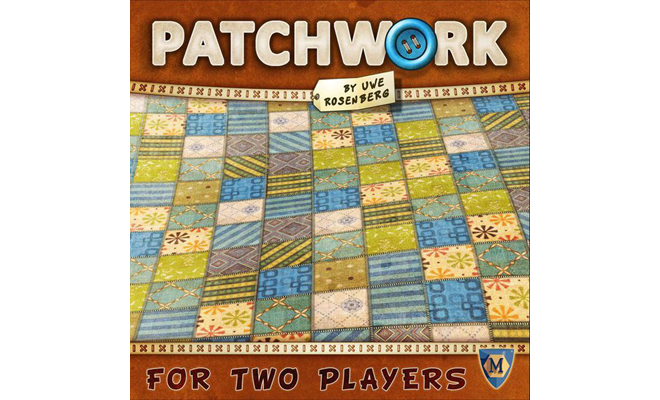A common question we are asked here at The Malted Meeple is “What game is best for two players?” While there is of course no wrong answer, the game that I prefer to recommend and to teach is Patchwork.
This unassuming game about creating beautiful patchwork quilts was designed by Uwe Rosenberg, the name behind titles such as Bohnanza, Glass Road, and Agricola. While many of his games are known for their complexity, Patchwork is incredibly simple and very approachable. I describe it as a bit like Tetris with patchwork pieces!
In the real world, patchwork is a form of needlework that involves sewing together pieces of fabric into a larger design. Historically, it was a way to make use of leftover pieces of cloth to create clothing and quilts and to avoid waste. In today’s world, patchwork has evolved into an art form. Designers like to use uneven pieces of fabrics to create especially beautiful textiles. Part of the challenge of creating a beautiful quilt is finding the best way to make the available patches fit together. It’s this challenge that drives Patchwork the game as well.
To set up a game of Patchwork, each player takes a quilt board and corresponding time token and places the time token on the time board in the middle of the table. Next, players will place the regular patches in a circle around the time board, and the small leather patches on the time board. Finally, place the Neutral token next to the smallest patch on the playing surface.
When playing a game of Patchwork, players will not necessarily alternate between turns. Whichever player’s turn marker is furthest behind takes their turn. It is possible that a player can take multiple turns in a row before their opponent can take one.
Each turn a player may either advance and receive buttons or take and place a patch. When advancing and receiving buttons the player moves their time token so that it occupies the space in front of their opponent’s time token, and then takes buttons equal to the number of spaces moved. When taking and placing a patch, the player chooses a patch from the three in front of the neutral token and moves the token to where the patch was last. They then pay for the chosen patch by returning a number of buttons to the supply and moving their time token on the time board. Finally, the player places the patch on their quilt board in any orientation they like. Once placed, the patch cannot be adjusted for the remainder of the game.
While moving the time marker, players will pass special spaces on the board. When passing a special patch on the board, take the patch and place it on your board. When moving past a button on the time board, the player earns buttons equal to the number of buttons on all of the patches on their quilt board. There is also a bonus tile which rewards seven buttons for the first player to successfully cover a 7 by 7 area on their quilt board. At the end of the game players lose two buttons for each tile they leave uncovered. The winner of the game is the player with the most buttons left.
We hope you will enjoy this delightful and unique two player game. On your next outing to the Malted Meeple, grab a pint of your favorite beverage and begin crafting your very own artistic tapestry!
Karington Hess is a lifelong gamer whose passions for hospitality and all things game-related led him to Ravenwood Castle, where he served as an Innkeeper before joining The Malted Meeple. When not pouring beers, crafting milkshakes, or teaching boardgames, Karington can be found behind the DM’s screen, weaving intricate stories for his fellow gamers.

